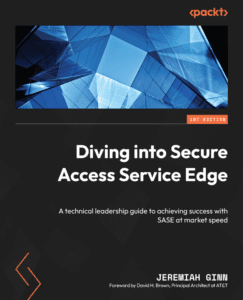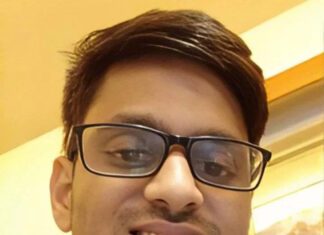Jeremiah Ginn is the author of Diving into Secure Access Service Edge we got the chance to sit down with him and find out more about his experience of writing with Packt.
Q: What are your specialist tech areas?
Jeremiah: SASE and SD-WAN.
Q: How did you become an author for Packt? Tell us about your journey. What was your motivation for writing this book?
Jeremiah: A Senior Executive from a top global entertainment company that has one of the highest performing networks in the world asked about teaching their team about SASE. The ask was due to my recent experience developing one of the first SASE solutions in production in the market that became an industry reference case. Anytime I am asked for something of this magnitude, I start over on my education from Zero. It does not matter how long I have been exercising a skill, I start over in my education when people are depending on me for success. My motivation was to help my customers take care of their people.
Q: What kind of research did you do, and how long did you spend researching before beginning the book?
Jeremiah: In all, my journey for this book was two years as I started over from Zero, not assuming my knowledge was the final answer even though I helped several thousand organizations with their SD-WAN and Security projects. It is important to re-evaluate your skill and restart your personal education on a regular basis which is what I did here.
I have spent two years working with The MEF Forum on SASE Service Attributes and Service Framework (MEF W117) where I have learned a great deal from the leaders in SASE development. During that time I have worked with many companies on their SASE journey.
Q: Did you face any challenges during the writing process? How did you overcome them?
Jeremiah: Throughout the writing of this book, my Packt team was patient with me through work, health, and family issues. I had many health setbacks that I had to overcome. We had a death in the family that also required us to take in two additional children for life. I often had eighty hour weeks from my work with AT&T. On average, I was traveling around 30% of the time and had to switch computers while writing from hotel rooms.
Everything that was overcome followed the same process. Every day, I got up and started over from Zero. Every day, I just started over and did the best I could that one day and pushed any other day into the background. My personal faith helps me reset and refocus on my priorities which are Wife, Children, Family, Church, Children, Veterans, and investing in people. My job is a conduit for investing in people and provides the financial resources for me to be where I need to be, when I need to be there, and with the ability to help without hurting my family. This book will further enable me to invest into the people that are investing in both Children and Veterans. My extended team spans across several non-profit organizations and ministries. It is my goal to enable them to keep doing great work. This is what drives me to complete projects like this book regardless of personal difficulties.
Q: What’s your take on the technologies discussed in the book? Where do you see these technologies heading in the future?
Jeremiah: For this question, you have to read the book. I wrote a whole chapter called SASE Forward to share with you these thoughts.
Q: Why should readers choose this book over others already on the market? How would you differentiate your book from its competition?
Jeremiah: SASE, like many current technologies is moving at the speed of DevOps cycles. Any deep dive on this topic is outdated between when the final copy is submitted for publishing and the actual publishing date. I purposely chose not to compete with inertia. This book is written with at least a ten year shelf life and hopefully lasts longer than that. This book is a tool to achieve success with any newly released technology in line with the pace of the market. The lessons that I incorporated work well for any secure communications use case across any known technology. The model for learning that I defined provides an approach for the next century.
This book specifically focuses on approaches for success for technical leaders to deliver secure communications across any technology or location.
Q: What are the key takeaways you want readers to come away with from the book?
Jeremiah: Always be learning…
Q. What advice would you give to readers jumping into this technology? Do you have any top tips?
Jeremiah: Start by re-learning how to learn. The approach to learning is what ultimately accelerates mastery of any subject matter.
Q. Do you have a blog that readers can follow?
Jeremiah: Connect and follow me on LinkedIn at https://www.linkedin.com/in/jeremiah-ginn-b315584/
Q: Can you share any blogs, websites, and forums to help readers gain a holistic view of the tech they are learning? What are the key takeaways you want readers to come away with from the book?
Jeremiah: Yes, sure. Here they are:
• https://www.nist.gov/
• https://www.mef.net/
• https://www.ieee.org/
Q. How would you describe your author’s journey with Packt? Would you recommend Packt to aspiring authors?
Jeremiah: Packt offered me an approach as a first time technical book author that enabled me to be successful. The schedule and project management helped keep me on track. The first time is hard but achievable with the team at Packt. I had multiple options and I am thankful that I chose Packt based on the experience.
Q. Do you belong to any tech community groups?
Jeremiah: Yes, these are the groups:
• https://www.nist.gov/
• https://www.mef.net/
• https://www.ieee.org/
Q. What are your favorite tech journals? How do you keep yourself up to date on tech?
Jeremiah: No, I don’t have favorite tech journals. I have published using this method and generally feel that the peer review process delays time to market on needed information. Peer review improves accuracy which is needed in some cases but often speed is needed. I use Google Alerts to identify what I should be learning. I leverage my personal network to validate information. I also use social media videos to get the 3-5 minute version on any topic I need to learn more about.
Q. How did you organize, plan, and prioritize your work and write the book?
Jeremiah: My primary writing time is Saturday morning for four hours immediately when I wake up. I average one hour a day, every day to support the editors at Packt. I do research during the week when a Google Alert is triggered. This is about four more hours a week. Weekly, the commitment is a minimum of eight hours and has not exceeded twenty hours in a single week.
Q. What is that one writing tip that you found most crucial and would like to share with aspiring authors?
Jeremiah: Write…no, just write…actually write…
If you are confused, re-read the previous statement. Every bit of advice from any previous author that I analyzed prior to writing pointed back to just writing.
We all have the ability to over analyze the writing process which means that no writing is occurring. Forget about every writing convention, standard, best practice, conventional wisdom, process, or anything you have ever been told.
The best place to start is to write your ideas in a brainstorming fashion without qualification of anything you write. You have to write your ideas purely as it comes out of your mind. Feel free to write the whole book without formatting and without telling anyone else you are doing it. You can take that raw version later and turn it into the correct format but if you focus on the method, you cannot get your thoughts on paper or screen.
Just write…
Q. Would you like to share your social handles? If so, please share.
Jeremiah: LinkedIn
You can find Jeremiah’s book on Amazon by following this link: Please click here









